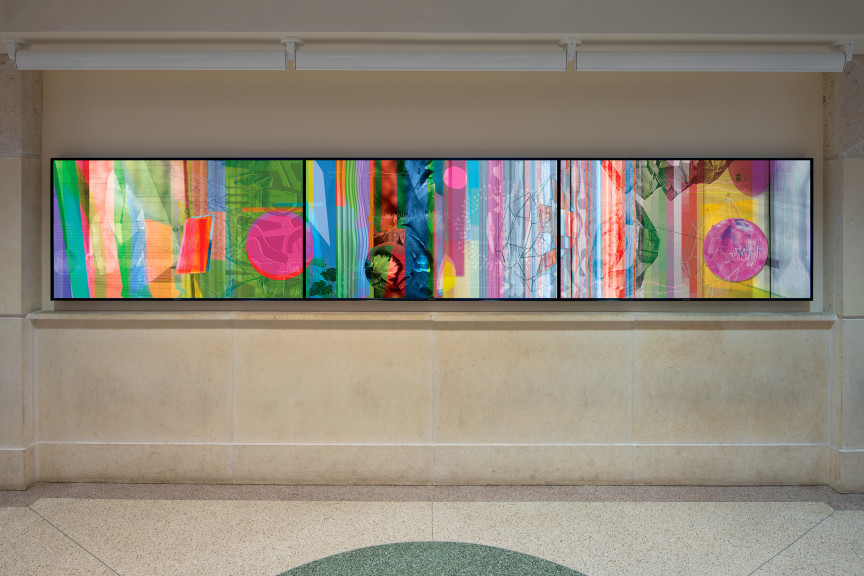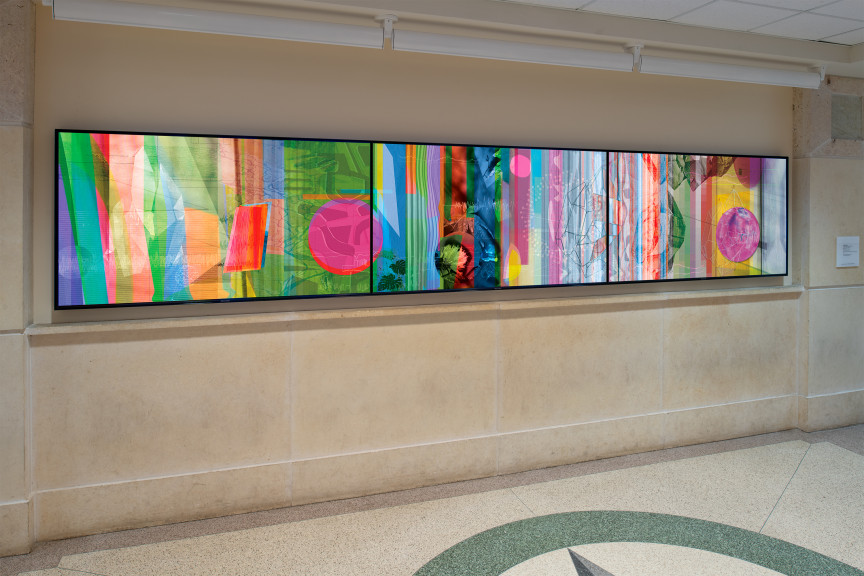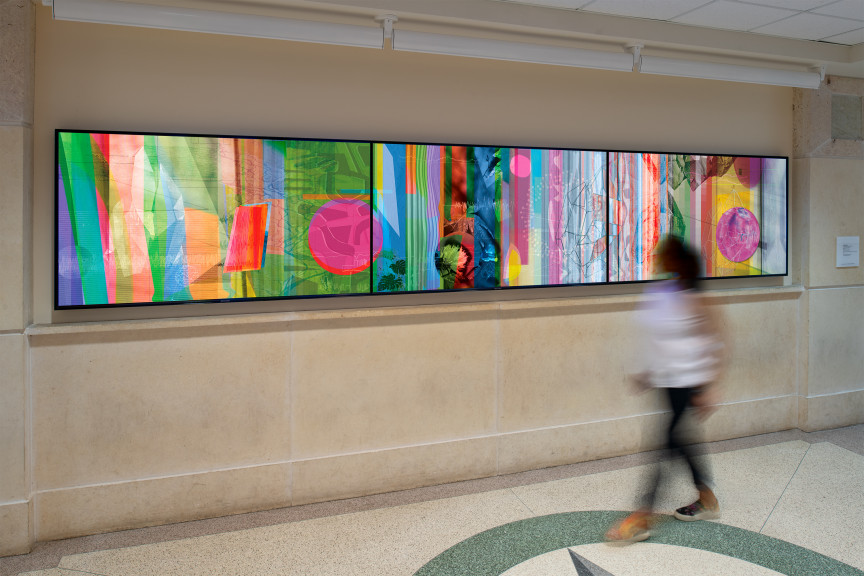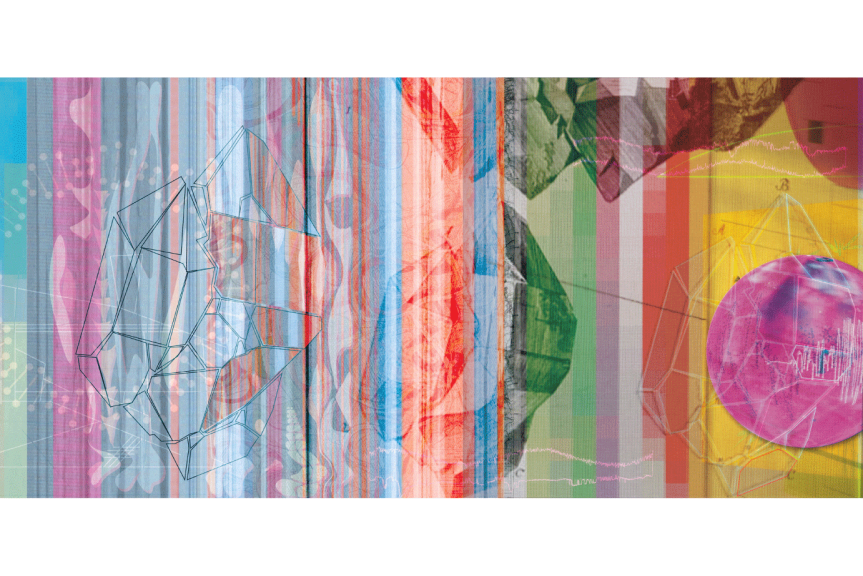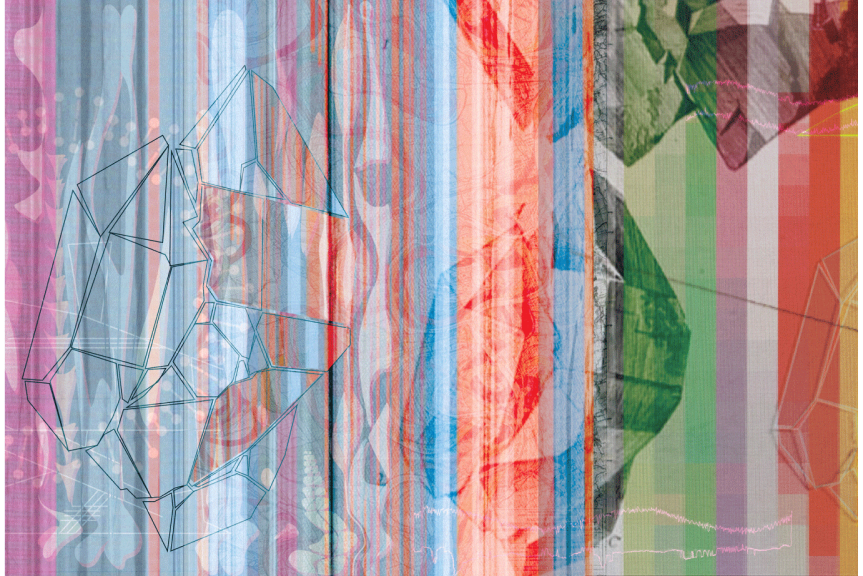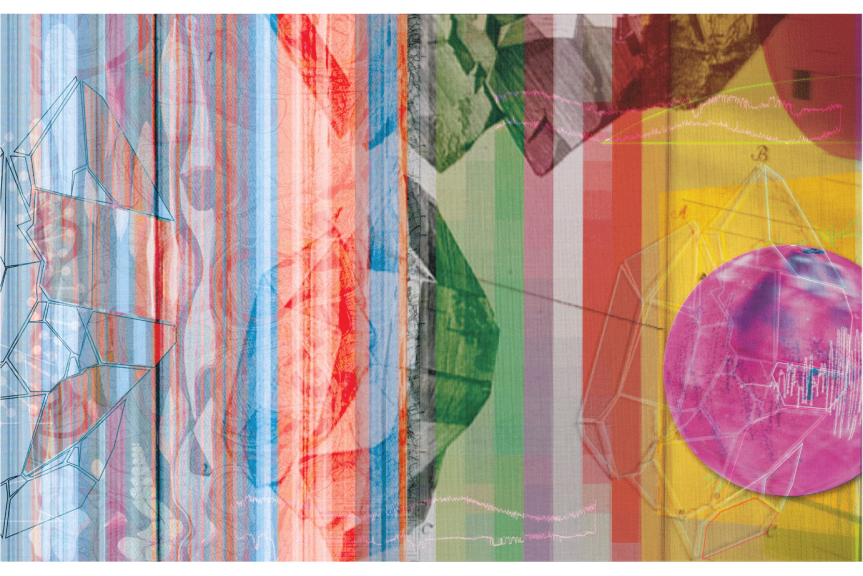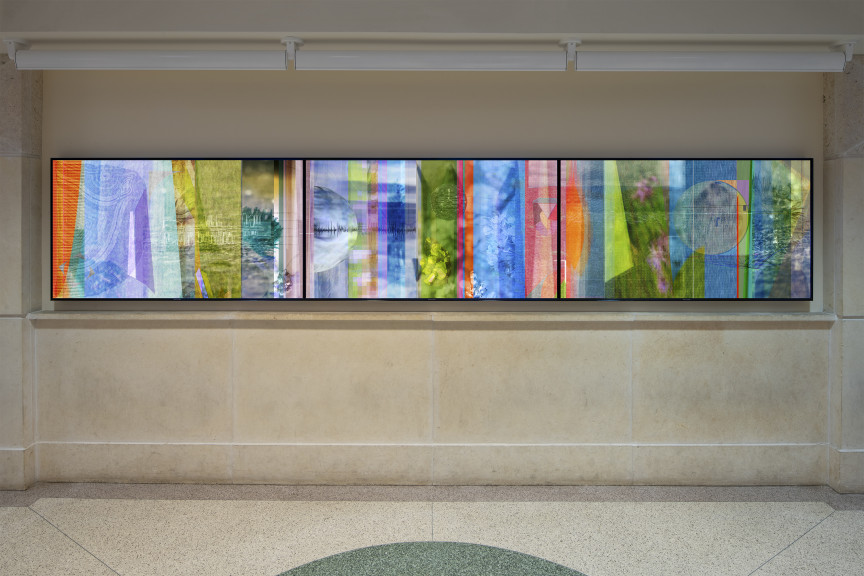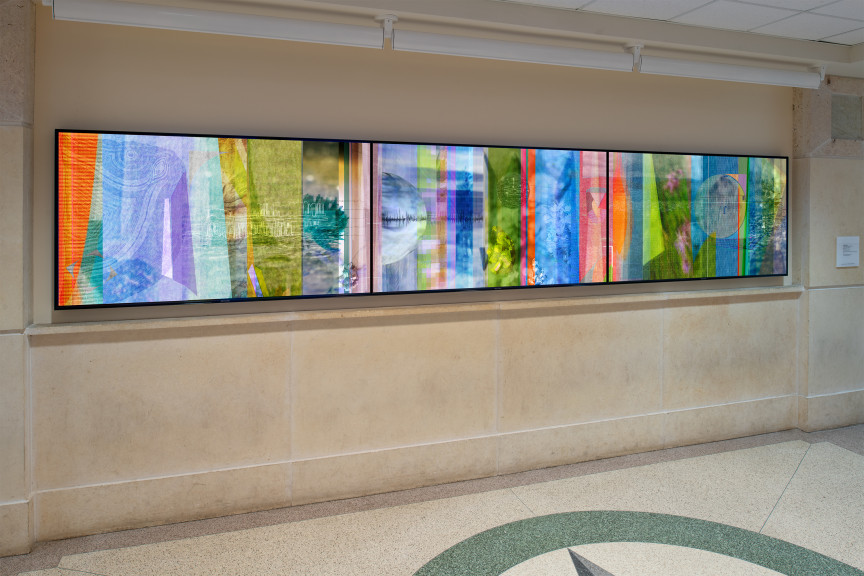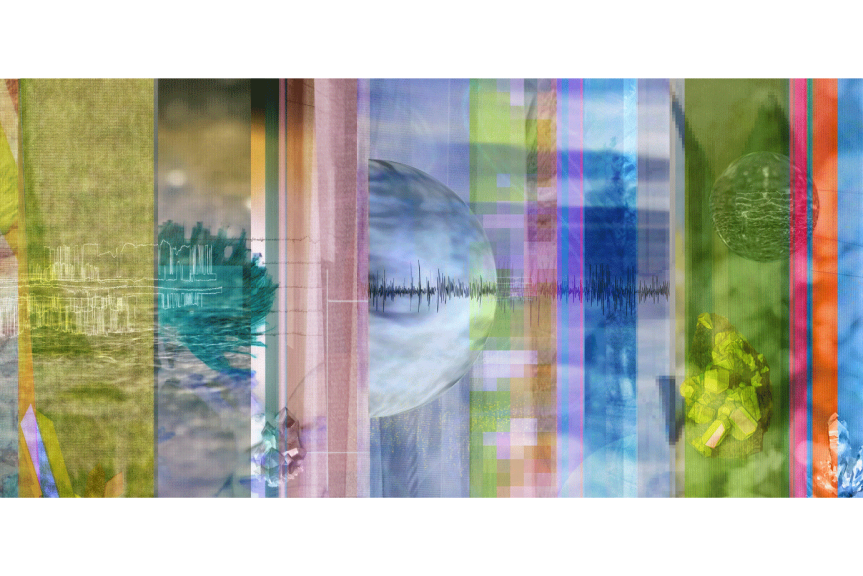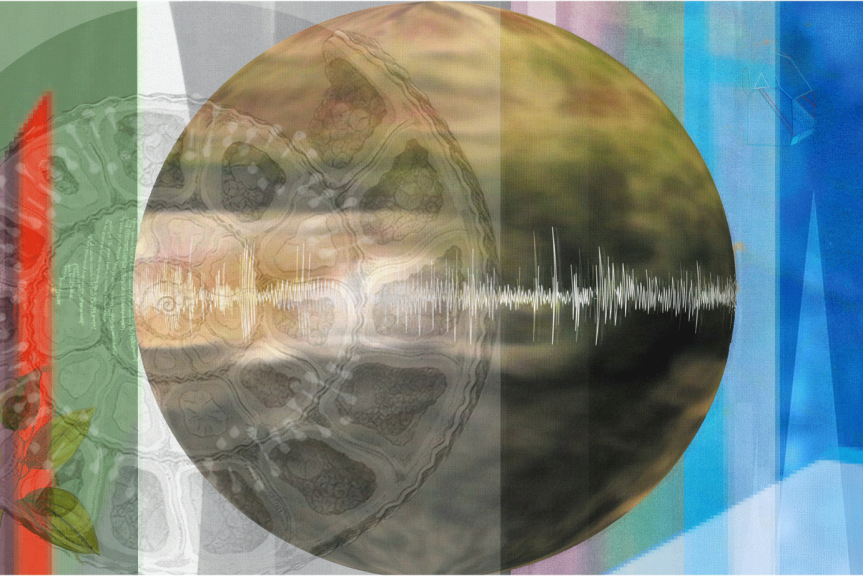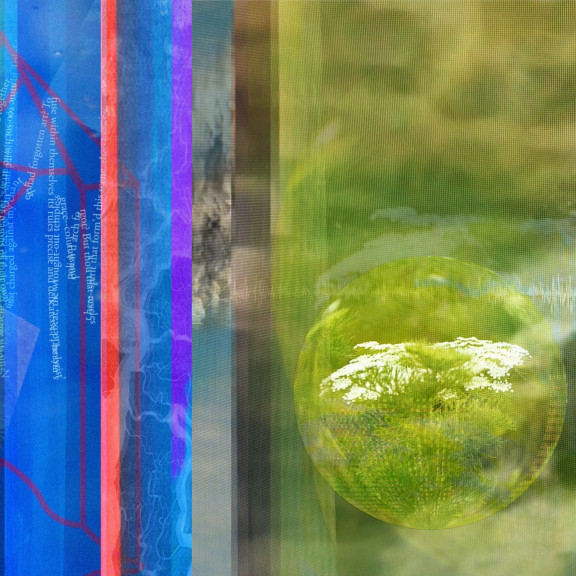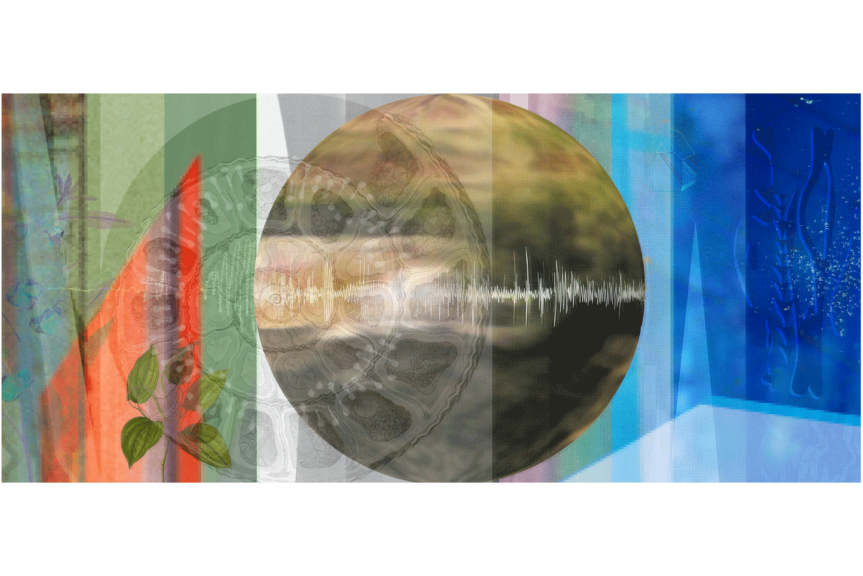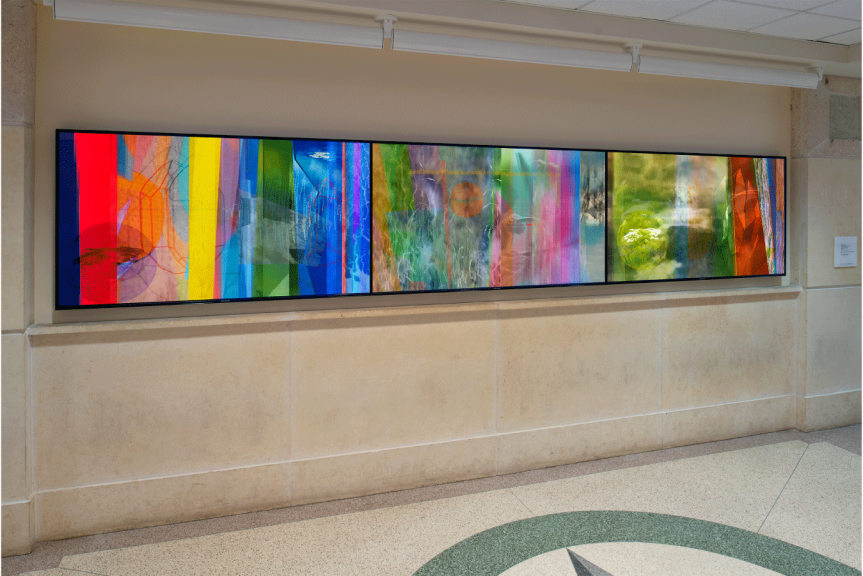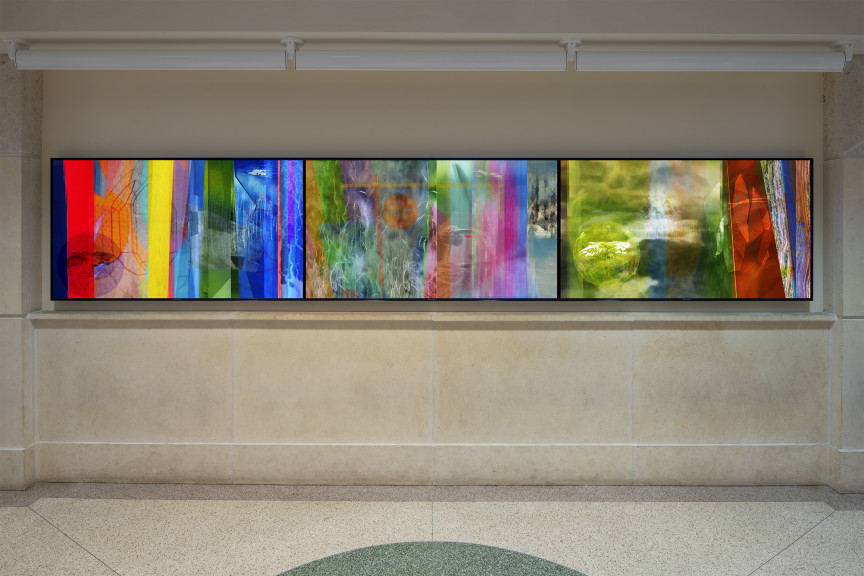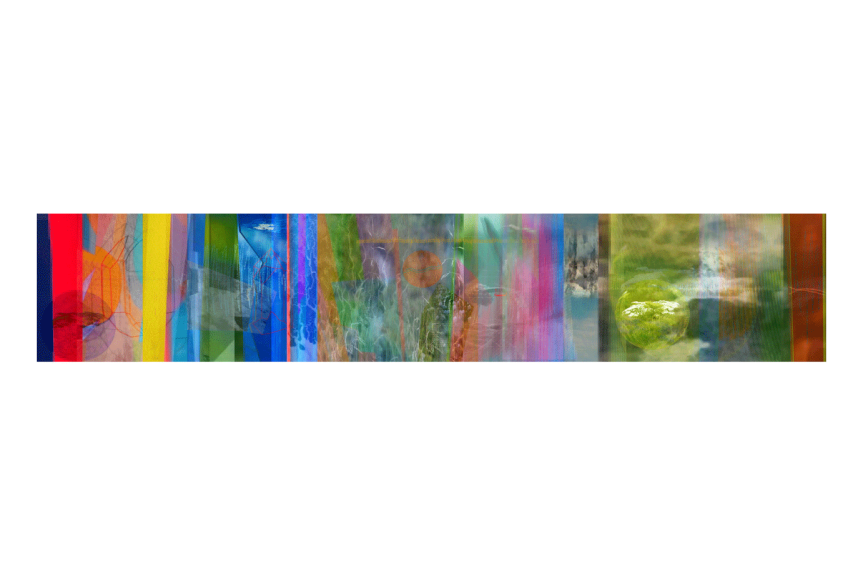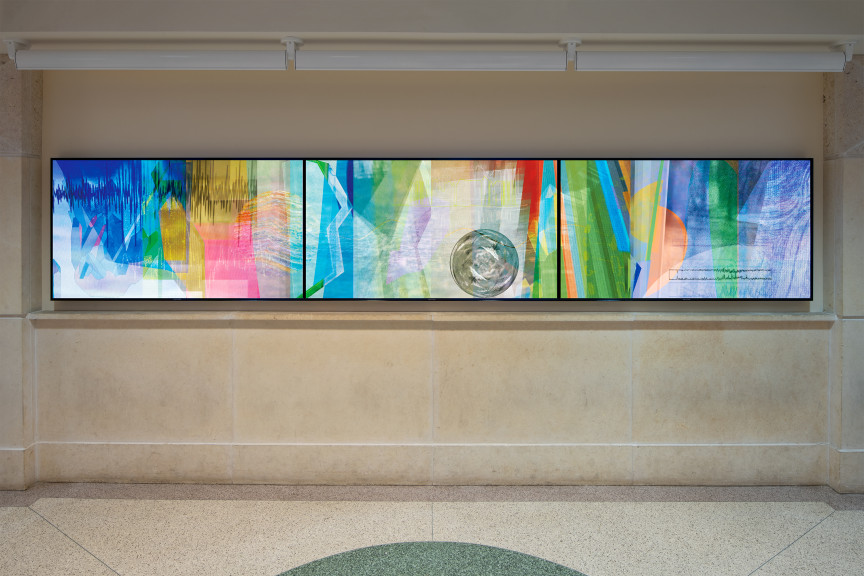An Interval of Time
Monika Bravo
34 x 186 inches
Commission, Landmarks, The University of Texas at Austin, 2020
GPS: 30.286104, -97.735734
Monika Bravo is a multidisciplinary artist who lives and works in Miami. Her still and moving images, sculptural installations, and interactive digital animations explore reality as perceived through our relationship to space and time. According to Bravo, her works “decipher the laws of the universe,” and are informed by spiritual teachings such as Taoism, Buddhism, the Vedaś, and evolutionary astrology. She creates environments that allude to recognizable landscapes but challenge traditional linear frameworks.
An Interval of Time chronicles the evolution of Bravo’s practice over the past decade and underscores her deepening interest in the interwovenness of metaphysical, spiritual, and scientific inquiry. A non-linear understanding of time guides the artist as she intertwines images, text, and, codes to create multi-layered animations. Drawing inspiration from the primary elements that make up our planet—earth, water, fire, and air—Bravo invites the viewer to consider how we reconcile our knowledge of the natural world within our own lives.
An Interval of Time includes geological data layered with visuals recorded in locations such as Iceland, New Mexico, Colorado, and the artist’s native Colombia. These scenes are juxtaposed with imagery that includes numbers, satellite imagery, weather graphs, and poetry. Bravo’s animation links empirical data and science to ancient indigenous weaving practices—emphasizing the universality of storytelling—be it through mathematics, painting, speech, or other means of communication.
Lodged between the space of knowing and not knowing, between nature and fabrication, Bravo’s work has a liminal quality. By decontextualizing data and removing it from its scientific purpose, she creates a new a symbolic language through which viewers are invited to reconsider their own relationship to time and the planet.
ACTIVITY GUIDES
An Interval of Time
Monika Bravo
Subject: Moving image
Activity: Create an image with two layers.
Materials: parchment paper, marker, found objects from nature, scissors
Vocabulary: layers, animation, forms, geology, weaving
Artist Monika Bravo uses a computer to make many layers of images. In this work, notice how many shapes come together to make a large moving image.
What do these forms look like to you?
How do you think the artist came up with these forms?
Using a marker, draw a shape from nature onto a piece of parchment paper, then, think of a similar shape, and draw the second one onto the other piece of paper. Have an adult cut each piece of paper into long strips. Weave the strips together until you have a rectangle. What happened to the shapes you drew once you cut them up and weaved them back together?
This work deals with the subject of geology which is the study of the Earth. The Earth has many layers of different soil and rocks.
Take this activity a step further by searching for and collecting objects with interesting shapes out in nature. Try tracing these objects and layering each traced outline with the various found objects you selected. What types of objects are easiest to trace? Which object’s outlines look best together?
Animation - Many images in a pattern that look like a moving object
Geology – The study of Earth and rocks
Weaving – Joining strips or pieces together to make a larger whole
Layer - A certain section of material on a surface
Form - A shape or outline of a shape
An Interval of Time
Monika Bravo
Subject: Moving image
Activity: Create a moving image with multiple layers.
Materials: strips of colored paper and parchment paper
Vocabulary: layers, forms, dynamic, weave/weaving
Artist Monika Bravo combines many different images and shapes to make an animation. Notice how the various forms come together to make a more dynamic work. Bravo, who has a background in fashion and photography, weaves together elements that often do not go together—like numbers, letters, images of nature, and shapes —into one final moving image that is continually changing.
What forms in this work of art do you recognize? Do they look different than how you might usually see them?
Choose the individual shape you find the most interesting. Why did you choose it? Do you think it goes with the things around it? How do the surrounding elements change the way you look at it?
Using a marker, draw any shape onto one of the strips of paper. Then, think of another version of that shape; think of giving it a different edge or changing its size. You could add numbers or words to change the original shape. Draw the new shape on the parchment paper strip. Continue with this process for each piece of paper and parchment that you have. Weave the strips into one another until you have a rectangle. Move the pieces back and forth. How does each new element change the original layer?
Monika Bravo is interested in the subject of time and uses the idea of time in much of her art. The title of the work of art includes “interval” which means the break between two events.
Look at An Interval of Time for as long as you can. Challenge yourself to notice every detail in the animation, then look back at your own creation. How are they similar? How are they different?
Weaving – Joining strips or pieces together to make a larger whole
Dynamic - Many parts in motion
Layer - A certain section of material on a surface
Form - A shape, outline, or object in an artwork
An Interval of Time
Monika Bravo
Subject: Composition and animation
Activity: Create a dunamic image with parts that complement each other
Materials: transparency sheet, permanent marker
Vocabulary: layer, animation, weaving, aesthetic, perspective
In this work, artist Monika Bravo uses a computer program to combine many small images into larger moving forms. She is interested in combining images and materials from different disciplines to see how putting them alongside each other can create a new sense of perspective. Notice how the work includes text, shapes, numerical data, and images of nature that are similar but not exactly the same. They all come together to create the completed work of art.
What are some of the shapes, forms, text, or images that stand out to you in this work? With what discipline do you associate each of these images?
Does looking at these figures alongside each other make you think about them differently?
Using a marker, draw any shape onto one of the pieces of parchment paper. Then, think of a symbol that you see on your phone or a street sign and draw that onto the next sheet. Continue with this process for each piece of parchment paper you have, coming up with a different type of image for each sheet. Look around you to find inspiration for your drawings. Do you see any man-made objects? Are there any natural objects in your view? What about letters or words? Once you have drawn on each sheet, put the shapes on top of each other and move the pieces back and forth. Find places that you can cut the paper and weave it together so that the layers meld together into one cohesive image. In your finished creation, how do your pieces rely on each other to create a new form?
Many of the artist's other works deal with the topic of time. “Interval” means a pause or break in activity, so the artist is inviting us to stop and really explore the animation. Try starting a timer on you watch, phone, or tablet. Have your parents start the timer and look at the work until you feel like you’ve seen everything you can in the animation. Have your parents stop the timer and guess how long you were able to look at the art. Did it feel like a long time? How close was your guess to the time on the timer?
Gaining “perspective” means we can change the way we look at something or the way we think about it. How do the layers in the work you have created relate to the layers in Bravo’s animation?
Animation - Many images in a sequence that create the illusion of a moving image
Layer - A certain section of material on top of or underneath other imagery
Weaving – Joining strips or pieces together to make a larger whole
Perspective – Observing or relating to a person, place, or object from a particular angle or point of view.
Aesthetic- The quality of how something looks
MORE INFORMATION
A native of Bogota, Colombia, artist Monika Bravo is a multidisciplinary artist who lives and works in Miami, Florida. Her still and moving images, sculptural installations, and interactive digital animations explore reality as perceived through our relationship to space and time. According to Bravo, her works “decipher the laws of the universe,” and are informed by spiritual teachings such as Taoism, Buddhism, the Vedaś, and evolutionary astrology. She creates environments that allude to recognizable landscapes but challenge traditional linear frameworks.
Moving and still images have always been central to Bravo’s practice. Her work presents a complex interplay of medium and materiality that rouses contemplation and awareness. She uses visual imagery as building blocks to construct a new dream-like reality that evokes questions and explorations of consciousness. For Bravo, time functions as a theme, a concept, and as a measure crucial to the human condition. She states:
“I believe that canonical Western culture conceives time as a linear narrative that always has a beginning and an end. What I propose, then, is that time be perceived as a circular material, with intangible cycles that give shape both to time and to space. Based on this idea, time for me becomes an essential artistic material.” ––San Martín, ArtNexus, 2017
This idea is a common thread in Bravo’s oeuvre, though her approach to recurring themes of time, space, and perspective varies. Her explorations of the scientific, philosophical, ancestral, or spiritual often reflect shifting viewpoints, but always feature the notion of duration at the core. Time is the catalyst for the manifestation of life, and her focus lies on what is beyond time, and how we, as human beings, approach these concepts universally.
In Symphasis, [simultaneous appearances], an installation from 2000, this idea is examined from a spatial perspective. The work places viewers in an “aquarium” where mirrors and light create a subjective sense of perception, inviting them to reflect upon and reconsider their reality. Bravo views her role as an agent who shifts paradigms of observation with works that open pathways to new possibilities.
For the time being (1998) is a time-based work that explores the extent to which we fill our surroundings with meaning and interpretation, given our emotional states. Over the course of a year, Bravo filmed with a static camera the same view from her Brooklyn apartment window. She captured storms, air, and light, juxtaposed poetically against the emblematic Brooklyn Bridge. The installation also includes Bravo’s recitation of verses from Ecclesiastes (3:1–8), affirming that time is not always defined or filled by what we see but how we see it. The meaning that we give to it is informed by our personal experiences.
Another time-based work, Landscape of Belief (2012), is a sculptural installation that calls into question how we construct our lives according to our belief systems. Animated skylines of recognizable cities, composed of the entire text from Italo Calvino's book Invisible Cities, are projected and floated diaphanously on glass panels. With carefully overlapped surfaces, the sculpture presents nothingness as an object, a metaphysical challenge to the viewer.
Urumu, Weaving time, and a later work, Arche-Types the sound of the word beyond sense, are interconnected by the importance of language as abstraction. Urumu (2014) is inspired by the landscapes, natural environments, and indigenous populations of Bravo’s native Colombia. Rooted in ancestral knowledge and textiles, it places viewers in an immersive technological environment where snippets of language are animated and layered to mimic the process of weaving. The work began with Bravo’s two-year residency with the Arhuaco people of the Sierra Nevada de Santa Marta, in which she decoded weaving practices.
For Bravo, technology serves as a vehicle for translating all the information she processes as an observer of life. In Urumu, Bravo draws upon ancestral traditions through practices of weaving and at the same time, reimagines them within a contemporary mode of abstraction through the usage of the technology. There is a direct relation between the binary systems of the loom and the computer, exemplified by the Jacquard machine that attaches to a loom in order to simplify textile production.
Arche-Types (2015) continues, albeit from a different angle, with the deconstruction of language as a metaphor. Commissioned by the Vatican Pavilion for the 2015 Venice Biennale, the installation draws on the first verses of John’s Gospel, “In The beginning there was the word,” and also from Zaum, which is an experimental poetic language developed by Russian Futurist poets that is characterized by indeterminacy in meaning.
An abstract interpretation of the Gospel in classic, cryptic Greek appears on monitors and floating glass supported by six colorful wooden panels, presenting text as form. This creates a non-narrative visual interplay where images of landscapes are combined with slow moving animations that quote Kazimir Malevich, a Russian Suprematist artist. In his manifesto, he declares: “Under Suprematism I understand the primacy of pure feeling in creative art. To the Suprematist, the visual phenomena of the objective world are, in themselves, meaningless; the significant thing is feeling, as such, quite apart from the environment in which it is called forth.” Through Arche-Types, Bravo aims to create space for giving meaning to the “Word” beyond language, exploring how we interpret the texts apart from their religious aspect and defying the idea that the sublime can only be reached through text.
An Interval of Time, commissioned for the Jackson School of Geosciences, is lodged between the space of knowing and not knowing, between natural phenomena and scientific inquiry. By drawing inspiration from the primary elements that make up our planet—earth, water, fire, and air—Bravo invites the viewer to consider how we reconcile our knowledge of the natural world with our anthropocentric lives. In turning to the geological, she alludes to a complex process of transformation occurring at rates invisible to us. The installation features geological data layered with visuals recorded in locations such as Iceland, New Mexico, Colorado, and her native Colombia. Animations—running on what the artist refers to as “circular canvases”—are displayed on three flat-screen panels. Streams of numbers, satellite imagery, seismic and weather graphs, and mineral geometry are combined with poetry that pays tribute to the earth. In a process of abstraction similar to Urumu and Arche-Types, Bravo decontextualizes the data by removing it from its scientific purpose and creates a new symbolic language.
First begun in 2010, Bravo’s newly completed project for Landmarks chronicles the evolution of the artist’s practice over the past decade and underscores her deepening interest in the interwovenness of metaphysical, spiritual, and scientific inquiry. With An Interval of Time, she has created a mesmerizing ode to planet Earth.
- Essay by Sana López Abellán with contributions by Alexandra Mendez, October 2020. Original essay contributed by Ombretta Agró.
An Interval of Time is a time-based digital work of art commissioned by Landmarks for The University of Texas at Austin.
First begun in 2010, the project chronicles the evolution of my artistic practice and personal development over the past decade. It reflects my interests in the metaphysical, spiritual, and scientific, and the ways in which they are interconnected.
Throughout my life, I have studied and practiced Tai-chi, I-Ching, meditation, nutrition, evolutionary astrology, and other disciplines. Recently, I am expanding my scope of work with Jungian psychology and by being part of international communities of “sense-making.” It is a privilege to teach and inspire; it has become my life’s aspiration.
The year 2020 is of great significance to me as it has presented us with the opportunity to dive deep and practice our skills of observation. By creating An Interval of Time, I have been able to integrate my myriad interests by conceiving a lyrical piece where layers are incorporated into a suggestive space and the infinite can be revealed. Through An Interval of Time, I have created an ode to planet Earth.
My practice has evolved throughout the last decade, becoming integrated with my personal and intellectual development— which I consider a quintessential part of my artistic career. I am no longer a seeker of truth; I embody my own perspective. I embrace my unique vision by consolidating all disciplines into one, creating a reality that matches my desire to evolve. At times, that translates into environments that contain mesmerizing images for public spaces. Other times, I create intimate actions between myself and other beings when I reveal their life purpose through astrological readings. And sometimes, I offer talks or workshops.
My essence is to connect, communicate, and inspire other beings to be themselves. I enjoy directing and producing diverse projects, from complex multimedia installations and public art commissions to artists’ books and textile design; I see no boundaries between the applied and fine arts. The only revolution is to be one’s self- I don’t want to be right, I am of service.
- Monika Bravo, Miami Beach 2020
An Interval of Time is commissioned by Landmarks for the Jackson Geological Sciences Building, Department of Geological Sciences - The University of Texas at Austin.
San Martín, Florencia “Monika Bravo: Time as a River and Materiality in her Work” ArtNexus, No 104 (2017) 36-41.
Cullen, Deborah "That Which Happens" NoName: [frequency + Repetition] Centro de Arte Caja de Burgos, 2005.
Dupuis, Dorothée and Monika Bravo. "Impulso Vital" Terremoto, February 10, 2020.
López, Beatriz. “A Tour of the Universe” nc-Arte, September 2, 2015.
Pakhoutova, Elena. "Accidentally on Purpose: Conversations with Monika Bravo and Youdhi Maharjan" The Rubin Museum of Art, 2019.
In 2011, Landmarks commissioned a digital animation by artist Monika Bravo for the renovated Jackson Geological Sciences Building in the Jackson School of Geosciences. The commission was put on hold from 2013-2019 due to technical difficulties with the intended site. In 2020, Landmarks proposed a new site within the building for the work, to which the artist and the Jackson School of Geosciences agreed. The work was modified to reflect time passed and was installed on the second floor of the building in 2020. Inspired by the geological data mined by scientists in the building, the site-specific animation enhances the architectural setting by digitally weaving together data and natural landscapes.
Funding for An Interval of Time was provided by the capital improvement project for the Jackson School of Geosciences’ Holland Student Center. Landmarks gives special thanks to the following:
Leadership
Andrée Bober and Landmarks
David Darling and the Office of Campus Planning and Facilities Management
Douglas Dempster and the College of Fine Arts
Jay Hartzell and the Office of the President
Landmarks Advisory Committee
Claudia Mora and the Jackson School of Geosciences
James Shackelford and Capital Planning and Construction
Larry Singell and the Office of the Executive Vice President and Provost
Project Team
Nisa Barger, project manager, Landmarks
Andrée Bober, curator and director, Landmarks
Monika Bravo, artist
Bill Haddad, technology manager, Landmarks
Patrick Sheehy, installation services
Special Thanks
Sana López Abellán, Monika Bravo studio
Ombretta Agró, former curatorial contributor
Andrea Ault, associate director, Accounting
Paul Bardagjy, photography
Christopher Bell, associate dean, Jackson School of Geosciences
Mark Brooks, project manager
Anton Caputo, communications, Jackson School of Geosciences
Pat Clubb, former vice president for University Operations
Nicole Evans, assistant dean Jackson School of Geosciences
André Fuqua, development, Landmarks
Christine Gwillim, education, Landmarks
Andrea Keane, event planner, Landmarks
Camilo Leyva, Monika Bravo Studio
Mary Margaret Kennedy, operations, Landmarks
Karen Marco, intern, Landmarks
Marla Martinez, Financial and Administrative Services
McKinney York Architects
Alexandra Mendez, curatorial contributor, Landmarks
Sharon Mosher, former dean, Jackson School of Geosciences
Juan Carlos Ortiz, Monika Bravo Studio
Umut Ozover, Monika Bravo Studio
Bill Powers, former university president
David Rea, former vice president of campus planning
Stephanie Sandoval, communications, Landmarks
Rend Shamma, Monika Bravo Studio
Christopher Stella, facilities, Jackson School of Geosciences
Kathleen Brady Stimpert, deputy director, Landmarks
Stephanie Taparauskas, development, Landmarks
Keith Westmoreland, Capital Planning and Construction
Robert (Thom) Wolfe, former project manager
Bryce Wolkowitz Gallery
Reagan Woodlock, design, Landmarks
Ali Wysopal, collections, Landmarks
Jade Yuman, Monika Bravo Studio

